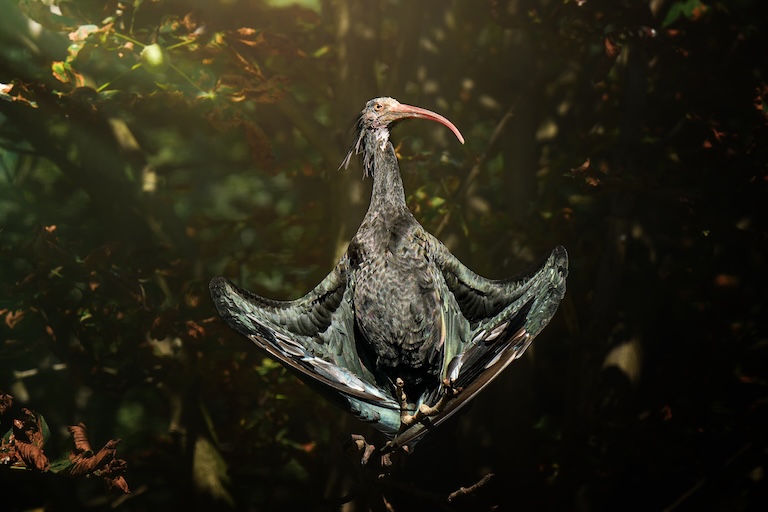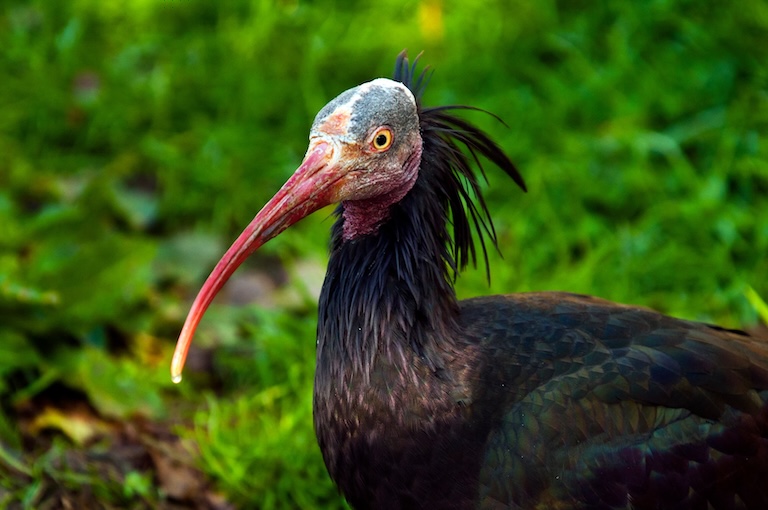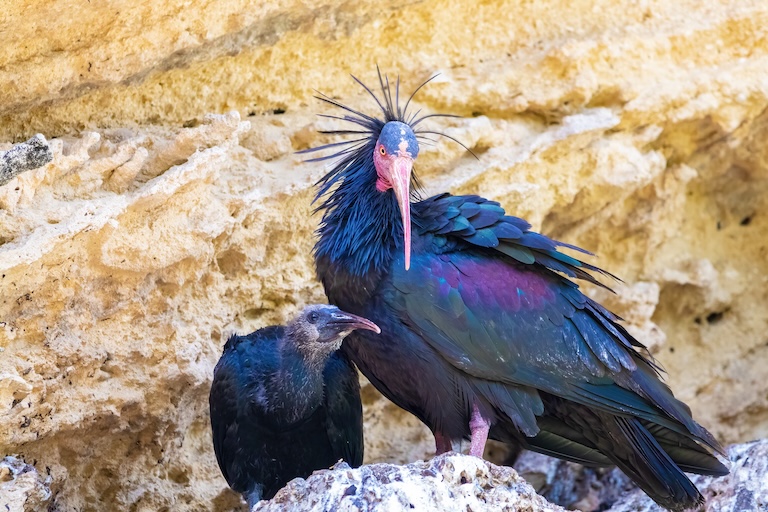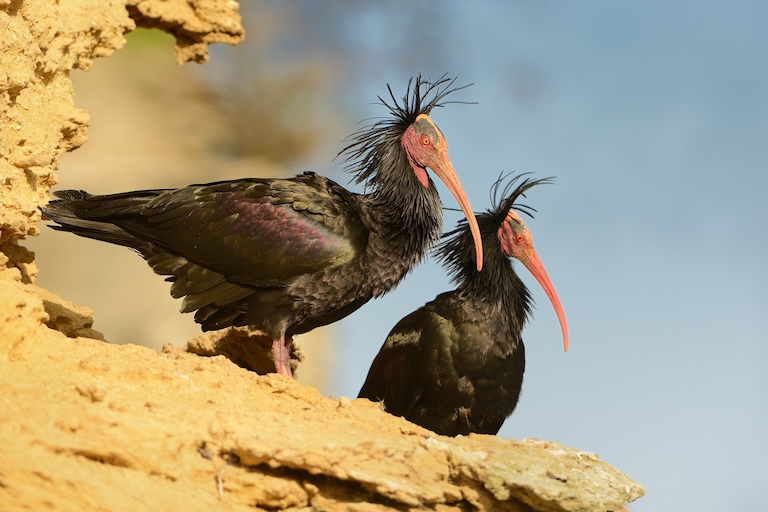Northern Bald Ibis Profile
Ibises are perhaps the single most divisive group of birds in human history.
This subfamily contains 13 genera, and species ranging from the quite literally Sacred ibis in Egypt to the “bin chicken” that functions very much like a raccoon: spreading trash all over the Sprawling urban landscapes of Sydney, Australia.
But the Northern Bald Ibis has both extremes in a single species. Here is a bird with the body of an iridescent jungle spirit and the face of someone who exfoliates with battery acid.

Northern Bald Ibis Facts Overview
| Habitat: | Rocky cliffs, remote, arid regions |
| Location: | Morocco, Syria, Turkey |
| Lifespan: | Up to 15 in the wild, 37 in captivity. |
| Size: | 80 cm (31 in) long |
| Weight: | Around 1.4 kg (3 lb) |
| Colour: | Black with iridescent green, bronze and violet; bald, red/orange face |
| Diet: | Mostly small animals, also plants, weeds, berries, shoots |
| Predators: | Brown-necked raven and Egyptian vulture |
| Top Speed: | Slow |
| No. of Species: | 1 |
| Conservation Status: | Endangered (IUCN) |
The Northern bald ibis nests in very remote areas and has few predators. Still, its population has been in decline for centuries and tanked substantially in more recent years.
These strange-looking, opportunistic omnivores were once very widespread and their range included parts of Europe, the Middle East and North Africa.
Today they are critically endangered but their populations have stabilised and captive breeding programs around the world stand a good chance of providing viable populations for reintroduction.
Interesting Northern Bald Ibis Facts
1. They eat all sorts of things.
This bird is not a fussy eater. The Northern ibis will eat any animal it can fit in its mouth, ranging from insects to small birds, snakes, lizards and fish. It doesn’t even matter whether it’s alive or dead.
From the salad menu, it will pick berries, shoots, duckweed, and plant rhizomes, terrestrial or aquatic, and it uses its long, curved beak to probe sands and soils to find them. 1

2. They’re gregarious
Like geese, these birds can often be seen flying in a V-formation, sometimes in flocks of more than 100 birds. They’re not particularly keen on long distances but will forage anywhere up to 15 km from the main colony, sometimes in farmland, where they can find plenty of food in the mud.
3. They nest on cliffs
Once they’re ready to breed, this species will differ from most Ibises and move up and away from the ground and the wetlands to build their nests.
They prefer remote cliff faces and areas near the steppe landscapes they can forage in during this period. As such, the combination of steppe and breeding cliffs is a limiting factor in the habitat for this species.
4. Climbers help them out
Nesting colonies will be spaced out loosely along the cliff faces, and being picky nesters, these spots can be hard to find.
Some groups of climbers have been known to volunteer their services to go up these cliffs and cut more nesting surfaces for these endangered birds, as well as take up artificial nesting boxes to help them out a bit. 2
5. They were once widespread
This is a species that was once found throughout the Middle East, across North Africa and even in much of Southern and Central Europe. Spain, Italy, Germany, Austria and Switzerland are all full of recent fossils of this species, and its original description by Conrad Gesner in 1555 was of a Swiss sample.
Around three centuries ago, it seemed to vanish from Europe and is extinct over much of its former range, with the vast majority forming the Moroccan population – a group of just 500 birds.
One individual, called “Shorty” appears to have become lost and overwintered in Switzerland to this day. She can be followed on the app Animal Tracker and has a statue built in her honour. 3

6. They’re coming to the end of a steep decline
Nobody knows exactly why this species has tanked in the last three hundred years, but it’s been in decline for at least this long.
Removal of habitat is a likely candidate, as is hunting, which was the major threat to the Syrian population.
In Turkey, poison played a big role, and pesticides reduced their breeding success. Electricity pylons are also known to kill these birds.
Ultimately, 98% of their decline occurred over the 100 years between 1900 and 2002.
7. They could come back
Conservationists are striving to protect the few that remain, and continued research and monitoring are underway.
Local authorities are urged to protect breeding sites and explore the possibilities of reintroductions. In the home of the first described Northern bald ibis, Vienna Zoo has a breeding program and next door in Innsbruck, Austria, a studbook of captive birds is maintained for this purpose.
Being a migratory species, their stop-over points are important, too, and captive-reared birds will have to be taught where to go between nesting and wintering sites.
But if all this goes to plan, Europe could one day see this strange, contradictory bird returning to its former range.

Northern Bald Ibis Fact-File Summary
Scientific Classification
| Kingdom: | Animalia |
| Phylum: | Chordata |
| Class: | Aves |
| Order: | Pelecaniformes |
| Family: | Threskiornithidae |
| Genus: | Geronticus |
| Species: | eremita |
Fact Sources & References
- “Northern Bald Ibis”, IUCN Red List.
- “Morocco Bald Ibis Project”, nomads.
- (2014), “Shorty back in Switzerland”, waldrappteam.
